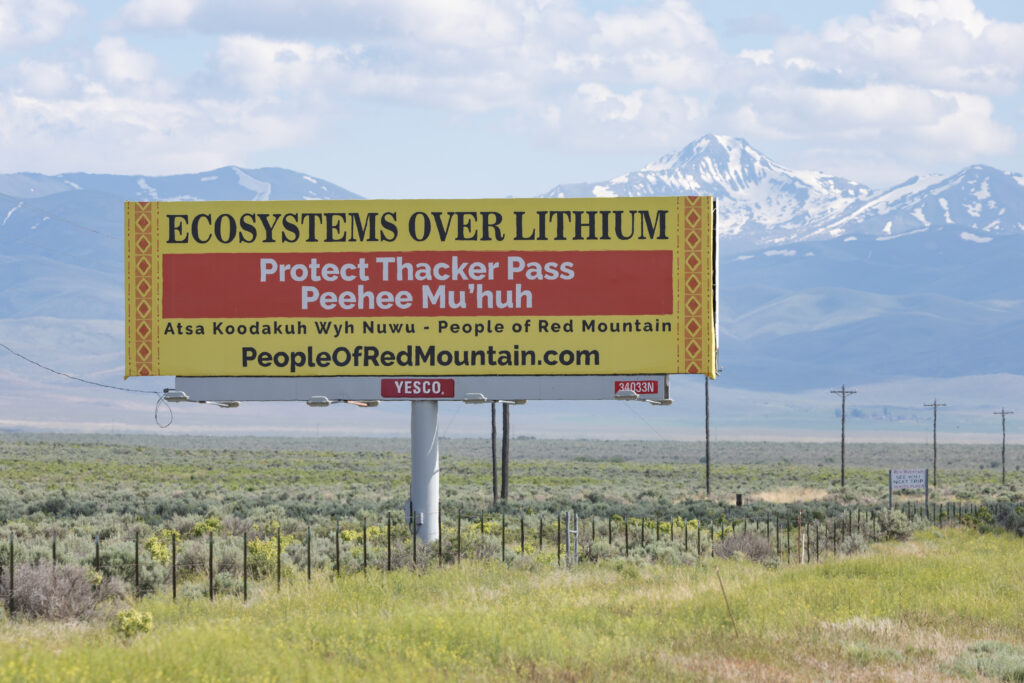 Photo Essay
Photo Essay
The Battle Against Lithium Mining at Thacker Pass
Jeff Schwilk / Truthdig August 28, 2023 Native Americans fight for the wildlife and fauna on sacred land. 11 photos This is Part of the "Green-Tinted Glasses" Dig series-

On May 11, 2023, after exhausting all legal avenues to stop the development of the Thacker Pass Lithium Mine, Native Americans from the Fort McDermitt Paiute-Shoshone, other regional tribes and non-native allies erected two prayer camps on the mine’s waterline, a pipeline that will supply the proposed mine with water from the nearby Quinn River Valley. This occupation effectively prevented the continued development of portions of the site.
-

A staging area along the water pipeline corridor at the Thacker Pass Lithium Mine is visible on the other side of a barbed wire fence with a no trespassing sign along the edge of the mine site. Lithium Americas Corp, a Canadian mining company, is in the first phase of constructing the Thacker Pass Lithium Mine, a 5,000-acre open pit mine that is projected to produce at least $2.2 billion of lithium. This site is located in Humboldt County, Nevada, near the small town of Orovada, and is within the McDermitt Caldera, the largest known deposit of lithium in the U.S. Most of this lithium will go to General Motors’ electric car division where it will be used for batteries. The current plan is to produce at least one million batteries per year from lithium sourced from this mine. This is the first of at least seven proposed lithium mines that will stretch north across the Montana Mountains and into southeast Oregon.
-
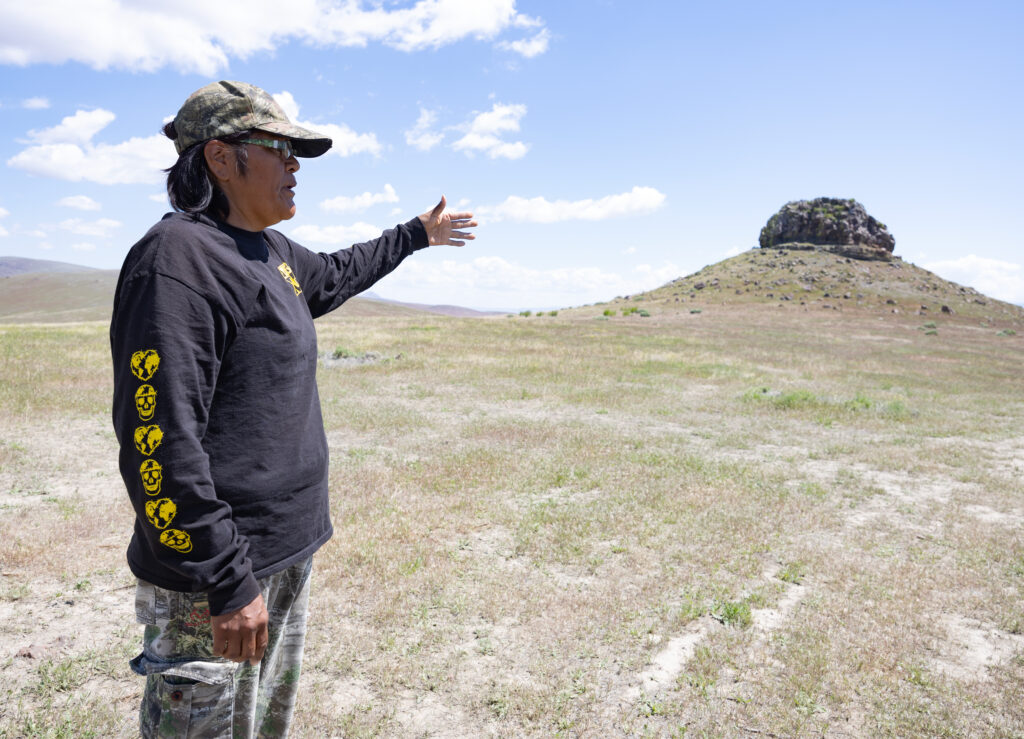
Dorece Sam, one of the main organizers of the protest/prayer camp against the Thacker Pass Lithium Mine. Dorece is a direct descendant of Ox Sam, one of three survivors of the 1865 massacre. Pee’zuh or Sentinel Rock, a sacred site in the vicinity of the mine, is in the background. Pee Hee Mu’Huh – “rotten moon” in Paiute” – refers to the first of two massacres that occurred at Thacker Pass. The first was an intertribal battle in the aftermath of which unburied bodies were left rotting on the landscape. The second massacre took place on Sept. 12,1865, when the U.S. calvary surprised a Paiute village, slaughtering dozens of people. According to two eyewitness accounts, federal soldiers murdered at least 31 Paiute men, women and children. “Squaws and little children sleeping in wickiups” were “shot down before they came to their senses.” A participant in the massacre stated that as they walked “from one wickiup to another, we went pouring in our bullets.” Ox Sam escaped as the calvary descended on his camp, cutting a hole in his wickiup and fleeing as the rest of his family was slaughtered. Dorece and the “Grandmas” formed the Ox Sam Newe Momokonee Noktun (Indigenous Women’s Camp) to protect the site of this massacre and other sacred sites from the development of the Thacker Pass Lithium Mine.
-
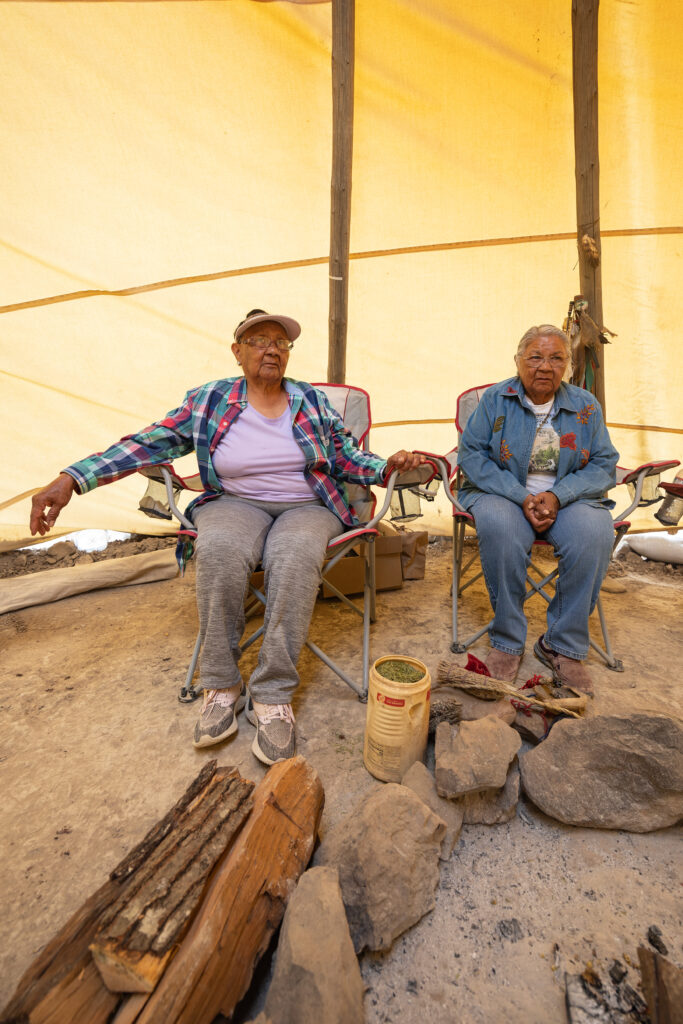
Elvida Sam Crutcher and Josephine (Sam) Dick, elders of the Fort McDermitt Paiute, sit in the teepee at the lower prayer camp. With their sister Dorece, Elvida and Josephine are collectively known as the “Grandmas” who are among the main organizers of this protest and are direct descendants of Ox Sam, one of the three survivors of the massacre that occurred at the site. The “grandmas” are the spiritual leaders of the Ox Sam Newe Momokonee Nokotun (Indigenous Women’s Camp) at Pee Hee Mu’ Huh, Thacker Pass. No important decision is made without consulting these elders first. Grandma Josephine is the vice chair of the Native American Church of Nevada.
-

A portrait of Wolf, one of the protestors at the Ox Sam Prayer Camp standing on the edge of the waterline. Pee’zuh (Sentinel Rock) can be seen in the distance. The occupation of the waterline began on May 11, 2023 when the prayer camp was set up to block progress on the mine. Once this camp was started protestors from across the country came to help maintain the camp and continue the occupation.
-

Early in the morning, Young Blood, one of the protestors at the Ox Sam Camp spontaneously breaks out into dance.
-

Disconnected pipes on the water line at the proposed Thacker Pass Lithium Mine. Once completed, the miles of pipe on this line will supply water to operate the mine, siphoning groundwater from the nearby Quinn River Basin and tapping into local aquifers. In phase one, “creation of lithium slurry,” the mine is estimated to use 847 million gallons of water per year. In phase two and for the rest of the life of the mine, at least 1.7 billion gallons per year will be used. It is estimated that 27,000 gallons of water is needed to produce one ton of lithium. As water is already a scarce commodity in this part of the world, there has been widespread outcry against the mine from local ranchers who depend on a naturally high water table to water their cattle and grow hay for feed. The BLM’s EIS expects a 10-foot draw down from wells within a mile of the mine’s two wells. With a likely future of drought, it is unknown as to what long-term effect this drawdown will have.
-
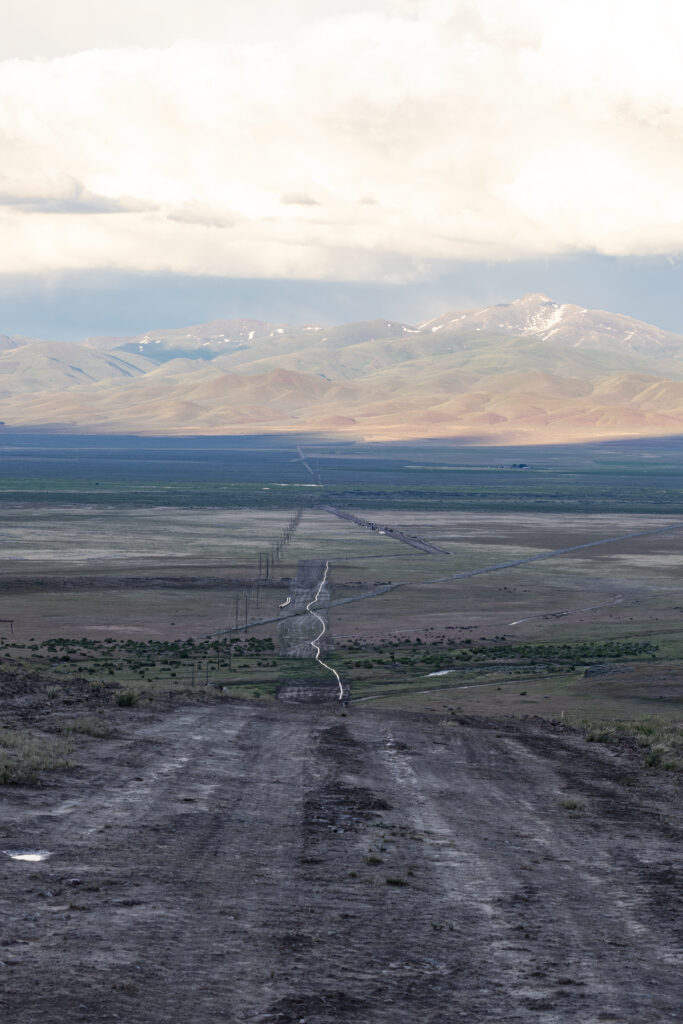
A view towards the east along the waterline into the Quinn River Valley, the source of all of the water for the proposed Thacker Pass Lithium Mine. This waterline will contain the pipe that will provide 1.7 billion gallons of water/year from the Quinn River Basin and nearby aquifers. The Santa Rosa Range can be seen in the far distance. This waterline will contain the pipe that will provide water needed to operate the mine from the Quinn River Basin and nearby aquifers. This water will be used in the processing of the lithium sourced from the mine. In phase one (creation of lithium slurry) the mine is estimated to use 847 million gallons of water per year. In phase two and for the rest of the life of the mine 1.7 billion gallons per year will be used. It is estimated that 27,000 gallons of water will be needed to produce one ton of lithium. As water is already a scarce commodity in this part of the world, there has been widespread outcry against the mine from local ranchers who depend on a naturally high water table to provide graze for their cattle. The BLM’s EIS expects a 10-foot draw down from wells within a mile of the mine’s two wells. With a likely future of drought it is unknown as to what the effect this will have on this region.
-

A vigilant burrowing owl (Athene cunicularia hypugaea) stands next to its burrow nest along one of the roads that bisect the mine site. These small owls are listed as a state priority species and have seen precipitous declines throughout their range due to habitat destruction. With the creation of this mine the population of burrowing owls at Thacker Pass will likely face extirpation.
-
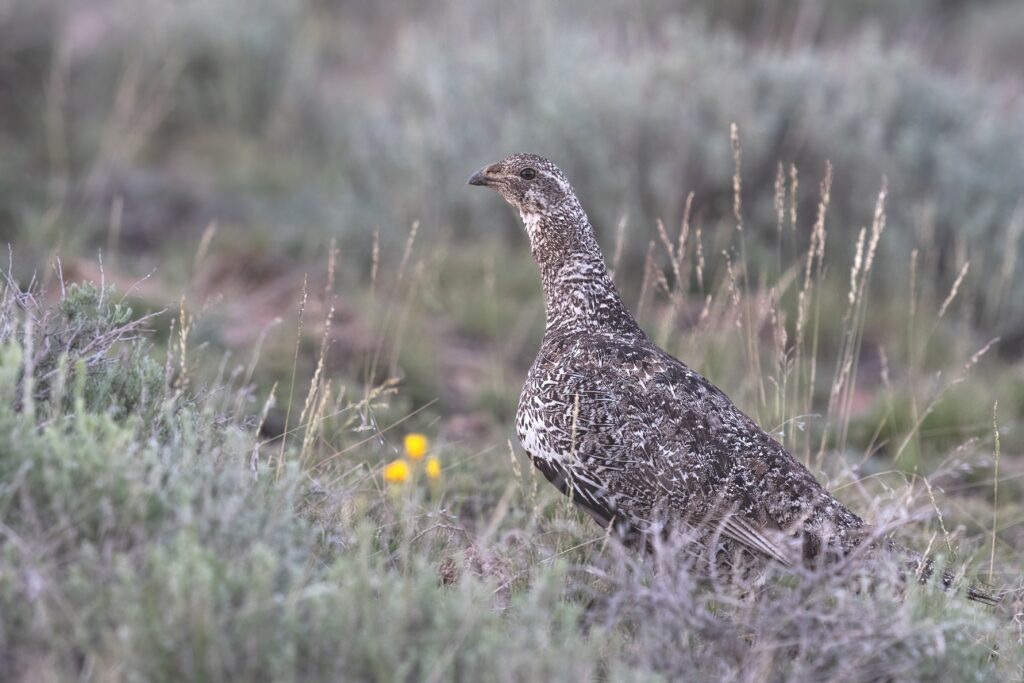
A male greater sage grouse (Centrocercus urophasianus) runs for cover in the Montana Mountains, a few miles the site of the Thacker Pass Mine. This large upland game bird is federally listed as near threatened and is a state protected species in Nevada. The greater sage grouse is a sagebrush dependent species and has seen precipitous declines across its range due to habitat loss and degradation from human activity such as mining, land conversion and range fires. The Montana Mountains are one of the last bastions of the species.
-

While a crew installs a chain-link fence on the water line next to one of the prayer camps, a bulldozer approaches. This incident occurred on a Saturday, surprising the protestors who quickly mobilized to record the movements of the bulldozer and work crew using drones and livestreamed video. A few days after this incident Lithium America sent an excavator and this bulldozer back to dig trenches close to the Ox Sam Camp. This incursion was met by land defenders who blocked the excavator and halted work. County sheriffs’ deputies soon arrived on the scene, called in by Lithium America, and proceeded to raid both prayer camps. One arrest was made, both camps were destroyed, and everything inside the camps were confiscated and held by Lithium America, including sacred objects.